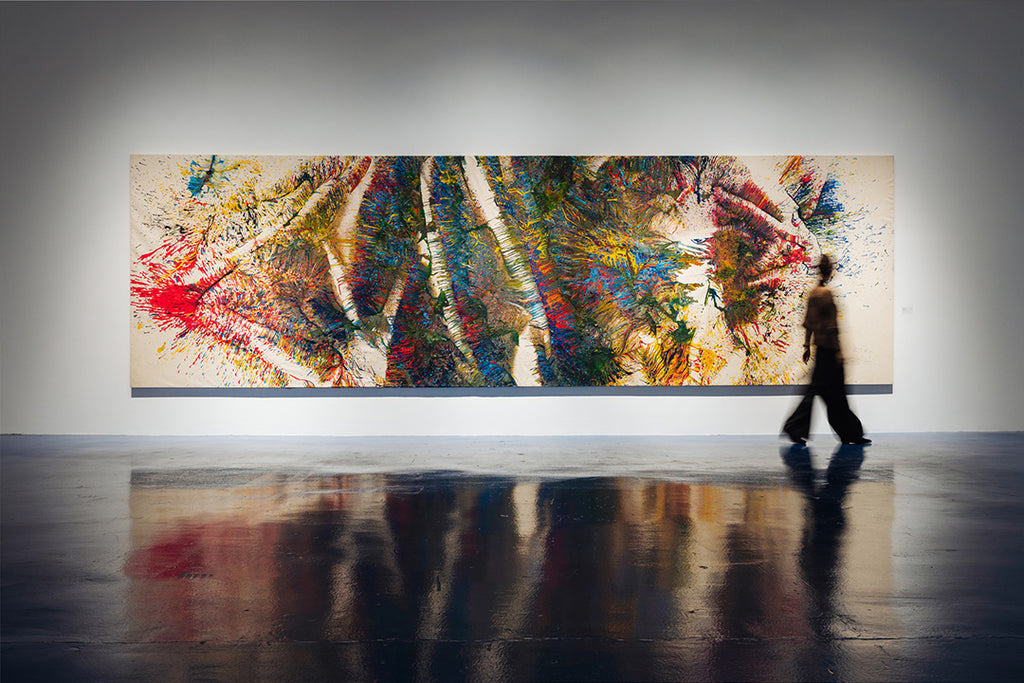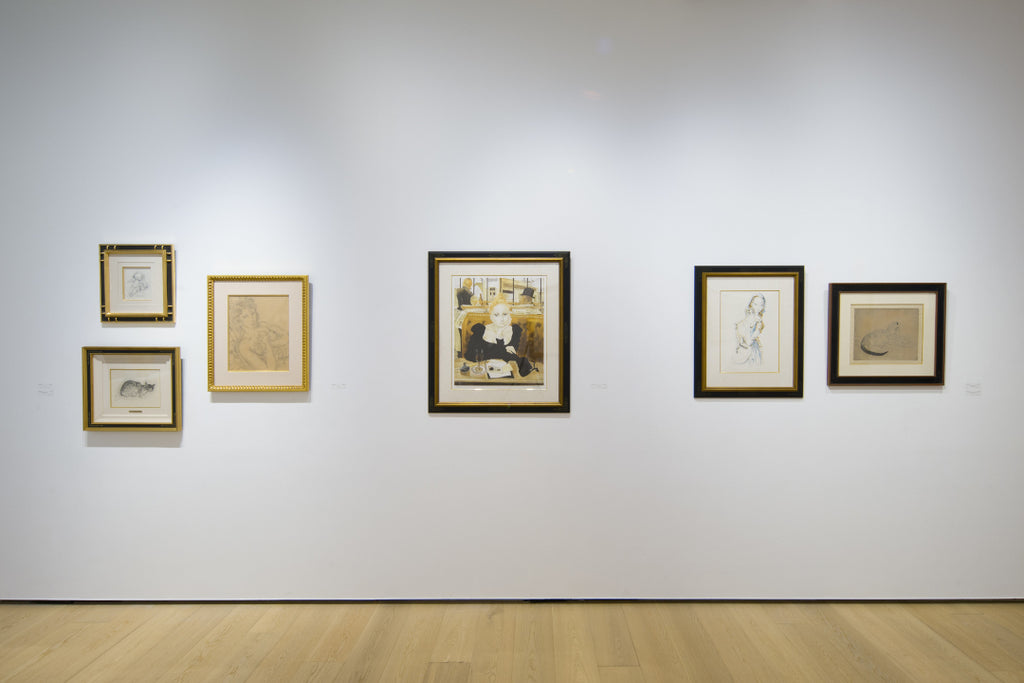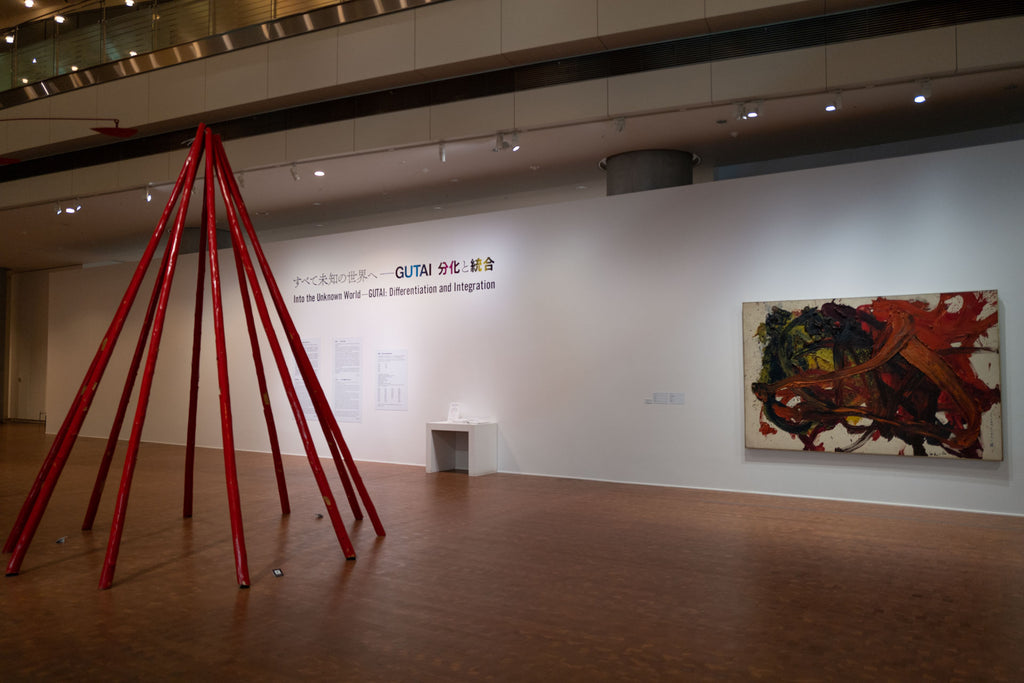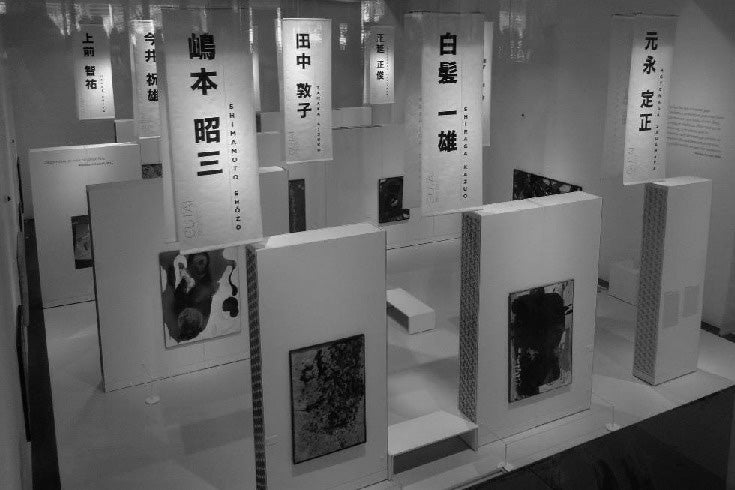ARTICLES
Gutai Art and Originality by Artist: Tsuyoshi Maekawa
GUTAI STILL ALIVE 2015 vol.1
12/35
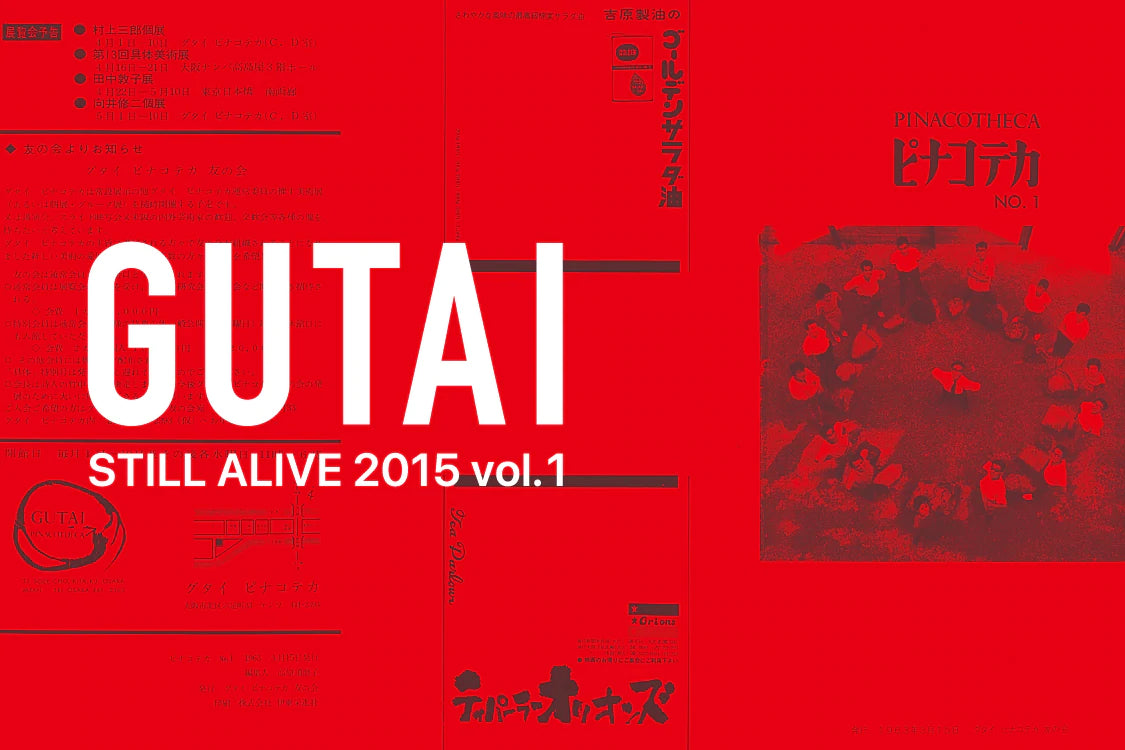
A project evolving the digitized archive of the book, “GUTAI STILL ALIVE 2015 vol.1”. The 12th edition features a dialogue between 2nd-generation Gutai artist, Tsuyoshi Maekawa and art historian, Kunio Motoe. They discuss the true nature of Jiro Yoshihara, and Gutai's emphasis on originality.
Second-Generation Gutai Artist Talks About Gutai and an Unknown Jiro Yoshihara
An Interview of TSUYOSHI MAEKAWA by Kunio Motoe
The art of Gutai Art Association is being revaluated. Museums in Japan and abroad feature Gutai artists. Their works fetch high prices at auctions. Gutai leader Jiro Yoshihara, Kazuo Shiraga, Atsuko Tanaka and others already passed away. But Chiyu Uemae and other artists who continue making works after the dissolution of Gutai are drawing attention. One of the so-called second-generation Gutai artists, Tsuyoshi Maekawa, talks about Gutai as he saw it.
From Modern Art to Gutai
Motoe: You are so stylish that you look like a designer rather than artist.
Maekawa: In fact, I used to be a graphic designer.
Motoe: Really!? You participated in Gutai art exhibitions since its 8th edition. What made you join the group?
Maekawa: At first I was interested in Modern Art Association and took part in their exhibitions a few times. Yoshio Hayakawa and Makoto Nakamura were among my seniors at high school. I used to visit them at their homes or ateliers. Then I got acquainted with Shozo Shimamoto, Chiyu Uemae and Yasuo Sumi, who exhibited at Modern Art Association also. They were exhibiting at Gutai exhibitions too. Thus I knew Gutai. Someone said to me, “You should show your work to Mr. Yoshihara, don’t you think?”
Motoe: What was your impression of Gutai?
Maekawa: Exciting. It was totally different from other art groups.
Motoe: Anyone could exhibit, right?
Maekawa: Yes. But only if Yoshihara said the work was good.
Motoe: Oh, I see. By the way, I heard that you broke the gate of Yoshihara’s house when you tried to bring in your work by a truck. Is that true?
Maekawa: Yeah, I remember. But the house was so old that few people noticed the accident (laughter).
Motoe: How old were you at that time?
Maekawa: Nineteen. Right after graduating from high school.
Motoe: How you were precocious! Gutai started in 1954. You were born in 1936 and became a member in 1961. According to material, Takesada Matsutani (b. 1937) and Shuji Mukai (b. 1939) are also among the second-generation Gutai artists. Yoshihara was around 50 years old at that time.
Maekawa: It seemed that French art critic Michel Tapié, who first acknowledged Gutai, had told Yoshihara not to increase members anymore. But the group was getting somewhat manneristic, so he decided to invite younger artists. It took four to five years to become a member.
Motoe: You remained a Gutai member ever since, right?
Maekawa: I never veered to other movements.
Gutai art of those days
Motoe: Can you tell me about Gutai at that time?
Maekawa: When I began to participate in Gutai exhibitions, a design magazine named “Idea” ran a feature on Gutai. I realized that Gutai was something beyond art. Such was the uniqueness of Gutai. I used to visit art galleries and competitions, but no longer did so after joining Gutai. Gutai was absolutely distinct.
Motoe: Really? What made Gutai so distinct?
Maekawa: The group itself was unique, of course. But its members, including Kazuo Shiraga and Sadamasa Motonaga, each had individuality and talent, perfectly. No other groups ever had such characteristics.
Motoe: You remained with Gutai until its end?
Maekawa: Yes. Since my 20s.
Motoe: Were such members rare?
Maekawa: No, members who left the group weren’t many. Atsuko Tanaka and Akira Kanayama left in 1965. Some trouble happened when we took part in Expo ’70, and Motonaga and Saburo Murakami left the group also. That’s it. Two years after Expo ’70, Yoshihara died. So we had no idea what to do, and disbanded.
Motoe: Was Yoshihara a dictator after all?
Maekawa: Yes, he was. He was old enough and already famous.
Motoe: So you never quarreled with Yoshihara?
Maekawa: No. For Yoshihara, I was maybe like a child (laughter). But actually he never treated me as a child. If I asked him to see my work, he did, even putting his work aside.
Motoe: In what situation did you show your work to Yoshihara?
Maekawa: We often gathered at his home in Nakanoshima, Osaka, or his villa in the city of Ashiya. We sat on the tatami and listened to Yoshihara. There was a storehouse in the yard of his home. He used to store prominent works in there, to display the works when some guests from abroad visited.
Motoe: Did the members stimulate each other?
Maekawa: We often discussed like who was the best in an exhibition, but didn’t usually stimulate each other. As opposed to other groups, Gutai members rarely talked about each other’s work. We only showed work to Yoshihara. Rather, we used to keep the work secret until the exhibition. We were emulating each other that way.
Motoe: Once Gutai drew attention in Europe and many performance artists went to Europe from Japan. That helped strengthen the impression of Gutai as a group of performance artists. What do you think about it?
Maekawa: I was personally interested in painting from the beginning, so I wasn’t much excited about their performances. By the time I joined Gutai, many had already stopped doing performances and shifted to painting, I remember.
Motoe: That means that at the beginning they were doing various things but finally they worked mainly in painting, right?
Maekawa: Outdoor exhibitions that the group used to do were ceased. By the way, for the 11th Gutai Art Exhibition I made a work named “Card Box” which I remade to exhibit at the Gutai exhibition in 2013 at the Solomon R. Guggenheim Museum.
Motoe: A “Card Box”?
Maekawa: Someone is in the box and if you put 10 yen in it, you can get a card. On the final day, other members told me to try myself, so I put the money and I got this card.
Motoe: Did Yoshihara write this?
Maekawa: He did his best to surprise me ... nobody else got such a certificate of commendation (laughter).
Motoe: Only Gutai people could know such an episode. It tells Yoshihara’s nice personality.
Works of jute
Motoe: Now I would like to ask about your work. You often use coarse jute. When did you start using it?
Maekawa: I liked its coarse texture from the beginning, and exhibited works using the material at Modern Art exhibitions. I started making works with jute with creases around 1962. There were some other artists who used jute, so I struggled to do something different.
Motoe: Did you sew this?
Maekawa: With a large needle. But later I realized glue also worked (laughter).
Motoe: How do you sew it?
Maekawa: On a sewing machine, pinching and stretching the cloth.
Motoe: Oh, I see.
Maekawa: After a while the cloth shrinks and there appear creases. But as I stretch it, the creases disappear. It’s not easy, but exciting.
Motoe: That doesn’t look easy. You won many prizes in the 1980s, right?
Maekawa: This series earned me many prizes. The method of making the creases disappear, pushing them toward the edges, drew attention. In other works I painted on the canvas with many wrinkles. Then I muddled the paint and stretched the canvas, and there appeared interesting voids and space.
Motoe: Was this done after Gutai?
Maekawa: Yes. After Gutai finished, I had to think myself what to do, and started this. Doing only this wasn’t a good idea, so I have changed my approaches, though.
Motoe: Why did you want to create such unevenness on the picture surface?
Maekawa: First of all, I wanted to do something different from other artists who use jute. Some artists paint on it, while others carve it or wrinkle it. I dip jute in glue. It takes awesome shape. I pursued such results, taking advantage of the characteristics of the material.
Motoe: Do you buy jute?
Maekawa: I buy it today. But it wasn’t easy to buy jute some time ago, so I asked for used rice bags, et cetera. It was also interesting. I made works by swelling jute bags only, but I somehow felt that they looked like someone else’s work, and put them in the storehouse. Later I brought them back and tore them, and they took exciting shapes. Then I started making works with holes.
Motoe: I see.
Maekawa: This, I made it by connecting nets. And I dyed it myself. Nice color, isn’t it?
Motoe: What the shape of your work based on?
Maekawa: Simplification. I make the shape the simplest and the least common possible.
Motoe: Do you simplify something concrete and render it abstract?
Maekawa: No, I don’t. Sometimes my work looks like a mountain or something, though.
Motoe: Art critic Shinichi Segi wrote in an essay that your concept is that the human is the skin, the world the outer skin and painting a surface. I was impressed by that. Are those your words?
Maekawa: No, I think Mr. Segi thought that way. I appreciate it.
Revaluation of Gutai
Motoe: These days Gutai is being revaluated. What do you think about it?
Maekawa: It’s like a dream. Yoshihara often joked, “You’ll be big sometime.” That came true. After decades (laughter).
Motoe: Did you ever think you should stop making works?
Maekawa: Never. If I enter in a competition and am rejected, I get disappointed but motivated even more.
Motoe: Are you proud of being a Gutai artist?
Maekawa: Of course I am, but even if I were alone, I would have been the same. Whatever, Gutai was almost everything to me.
Motoe: Maybe you have a high artistic spirit.
Maekawa: What we had done was acknowledged in overseas. That gave us a lot of confidence. People abroad often say it was the first time since ukiyoe. They say that Gutai’s art is true art, because it’s original, that other Japanese artists’ works just look like Renoir, Utrillo, and so on.
Motoe: You are highly valued abroad too.
Maekawa: Informel artists in Europe used to say Gutai artists imitated them. But now they say they acknowledge us after all. Some Gutai works may look like something like homage to Informel, but such Gutai works often turn out to be older than Informel’s. We are proud of that. Any Gutai artist’s success is wonderful to all other members. I want to be in the Gutai group anytime.
Motoe: When I see Gutai exhibitions today, I don’t feel that the works are old. That may be thanks to the group’s originality.
Maekawa: Somebody once said, “How can you say your work is original? Someone else may have done the same thing somewhere in the world.” Thus they give up from the beginning. If someone else is doing the same thing, you just have to contest. This is the spirit characteristic of Gutai, I think.
Motoe: I see. The revaluation of Gutai may owe to such spirit seen in each artist’s work. I think young painters today should learn from it. I wish you further success. Thank you very much.
(Gekkan Bijutsu, August 2013)
Read more about the “Gutai Art Association »
*Information in this article is at the time of publication.
ARTIST

마에카와는 삼베를 그의 생애에 걸쳐 주요 창작 재료로 사용해 왔으며, 삼베는 그를 상징하는 존재가 된다. 마에카와가 등장하기 전에 미술사에서 Joan Miró와 Alberto Burri와 같이 삼베를 사용하는 예술가가 몇 명 있었지만, 마에카와는 일생을 삼베의 물질성에 대해 연구한 최초의 인물이다. 또한 캔버스에 삼베를 입체적으로 붙이거나 꿰매는 것뿐만 아니라 반드시 유채로 채색을 하는 것이 마에카와의 특징이며, 3차원을 지향하면서도 회화라는 2차원에서 벗어나지 않겠다는 작가의 고집이 느껴진다. 마에카와는 무카이 슈지 와 마츠타니 타케사다를 포함해 구타의 2세대를 대표하는 인물이며, Gutai가 해체된 이후에도 해외에서 많은 전시를 통해 창의적인 작품 활동을 멈추지 않고 있다.
